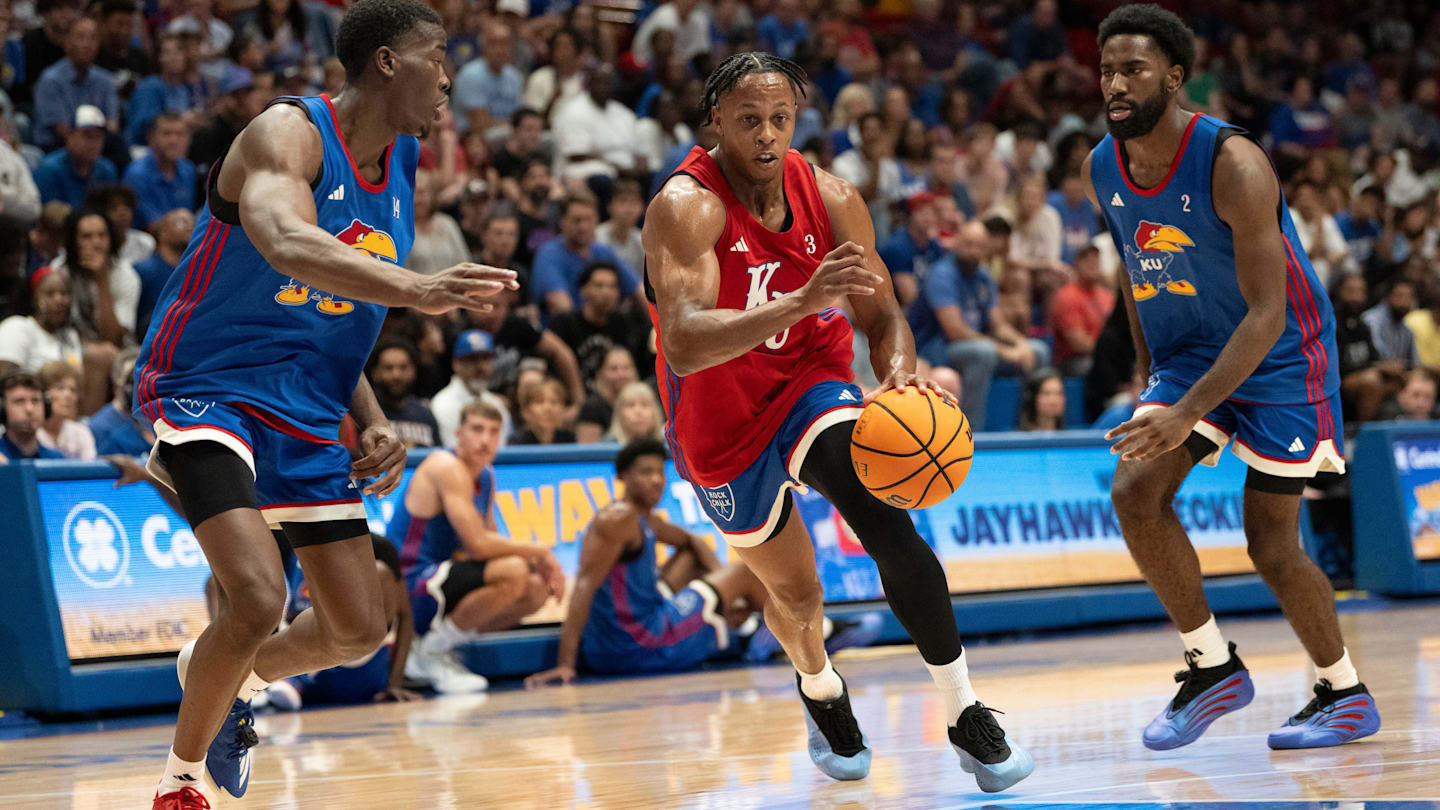If basketball teams were only as good as their best player, the Kansas Jayhawks might enter this season as national title favorites.
Darryn Peterson has the potential to be not just the best freshman, but one of the best players in the entire country. Still, that doesn’t mean KU’s roster is without weaknesses this season.
There are several reasons why many analysts remain skeptical of the Jayhawks heading into 2025–26, beyond the fact that the past two years in Lawrence haven’t exactly been vintage Bill Self basketball. Let’s explore exactly what is viewed as a strength and a weakness for Kansas.
Kansas Basketball Strength: Defensive Potential
Perhaps the biggest strength going into the season is KU’s defensive upside. After two years of soft interior defense with Hunter Dickinson, returning sophomore Flory Bidunga is set to anchor the paint.
In limited minutes last season, he averaged 1.6 blocks per game to rank third in the Big 12, and he will now step into a full-time starting role. Opponents will think twice before driving to the paint simply because of his presence.
Incoming freshman Paul Mbiya adds another layer of rim protection with a 7-foot-8 wingspan and a physically imposing frame.
In the backcourt, KU has strong point-of-attack defenders like Melvin Council Jr. and Jayden Dawson, which should take some pressure off Peterson on that end. Council averaged 2.1 steals per game last year at St. Bonaventure, while wings such as Tre White and Kohl Rosario bring length and athleticism.
If there is one thing we know about this Jayhawk team, it is that defensive stops will be its forte.
Kansas Basketball Weakness: 3-Point Shooting
Peterson projects as a terrific shooter beyond the arc and will attempt the bulk of the threes for the offense, but there are questions about how his supporting cast will shoot the rock.
Bidunga has never attempted a collegiate 3-pointer, while projected starters Council (28.3% lifetime) and White (30.1% lifetime) aren’t exactly the most reliable outside threats. Meanwhile, Elmarko Jackson shot just 12-for-45 (26.7%) as a freshman before his injury last year.
The two most realistic 3-point shooting options on the roster aside from Peterson are Rosario and Dawson, who shot 36.3% from three at Loyola Chicago last year.
Rosario is more of an unproven shooter, but it was one of his strengths at Overtime Elite, and he will undoubtedly pull the trigger when left open. Regardless, just like last season, the Jayhawks could struggle to find consistency from long range.
Kansas Basketball Strength: Backcourt Depth
If there is one thing KU has this season, it is depth at the guard position. The Jayhawks have so many players in the backcourt that three of them (Nginyu Ngala, Jamari McDowell, and Corbin Allen) are already looking from the outside in.
Those players will likely see some early-season action, but it is the established guards who will get most of the playing time.
Still, with the length of the college basketball season and the inevitability of injuries, it is encouraging for the coaching staff to know that it has reliable depth pieces ready to step in and provide a boost when needed.
Kansas Jayhawks guard Jamari McDowell (11) passes the ball against Washburn in the first half of the game inside Allen Fieldhouse Tuesday, Oct. 29, 2024. / Evert Nelson/The Capital-Journal / USA TODAY NETWORK via Imagn Images
Kansas Basketball Weakness: Lack of Experience
The Jayhawks have had one of the most experienced rosters in college basketball over the past two seasons, and ironically, that experience didn’t lead to much success. So, take this one with a grain of salt.
But overall, the numbers suggest the more experienced teams in college basketball have typically fared better over the past few years.
Entering this campaign, KU finds itself on the opposite end of that narrative. The only returning contributor who saw minutes last season is Bidunga, who has just six collegiate starts under his belt.
Other key pieces like Peterson, Rosario, Mbiya, and Samis Calderon are all incoming freshmen who haven’t played a single college minute. Even the transfers like Council, White, and Dawson have never suited up for the Jayhawks before.
That leaves Bidunga, Jackson, and McDowell as the only players with prior experience in Coach Self’s system. That is not necessarily a bad thing, but it might suggest there could be some early growing pains as this group learns to play together and adjusts to the scheme.
Kansas Basketball Strength: Transition Offense
Many of the points that will be scored are likely to come in the fast-break game. Peterson and Jackson can run the floor with the best of them as lead guards, and this roster has been built to play fast.
Expect the Jayhawks to constantly push the tempo off of rebounds, with players like Bidunga and Mbiya serving as lob threats, and shooters such as Dawson and Rosario spacing the floor for open transition threes.
Peterson’s ability to attack downhill and draw contact should also result in plenty of free throw opportunities in transition situations.
Kansas Basketball Weakness: Secondary Scoring Option
As is the case with many teams centered around one superstar, the 2025-26 roster lacks a proven second scorer behind Peterson.
He will carry the majority of the offensive load, but no player can do it all himself. While Peterson’s presence will undoubtedly make those around him better, who is going to step up when he is getting a breather or having an off-night?
Until a clear secondary scoring option emerges, the Jayhawks could experience ugly stretches on offense. Whether it is White, Council, or Dawson, someone will need to establish themselves early as that complementary threat.

